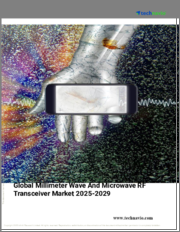
|
시장보고서
상품코드
1623846
FlexRay 트랜시버 시장 규모, 점유율, 성장 분석, 구성 요소별, 용도별, 지역별 시장 규모, 점유율, 성장 분석 - 산업 예측(2025-2032년)FlexRay Transceivers Market Size, Share, Growth Analysis, By Component (Transceivers, Microcontrollers), By Application (Automotive, Industrial Automation), By Region - Industry Forecast 2025-2032 |
||||||
FlexRay 트랜시버 세계 시장 규모는 2023년 1,248억 9,000만 달러로 2024년 1,328억 8,000만 달러에서 2032년 2,182억 7,000만 달러에 이르고, 예측 기간(2025-2032년) 동안 6.4%의 연평균 복합 성장률(CAGR)을 나타낼 전망입니다.
세계 FlexRay 트랜시버 시장은 최신 자동차에서 고속 데이터 통신에 대한 필요성이 증가함에 따라 꾸준한 성장세를 보이고 있습니다. 자동차 제조업체와 1차 협력업체들이 신뢰할 수 있고 효율적인 통신 솔루션을 우선시하는 가운데, FlexRay 트랜시버는 자동차의 다양한 전자 시스템 간 실시간 데이터 전송을 가능하게 함으로써 중요한 역할을 하고 있습니다. 이 기능은 잠금 방지 브레이크 시스템, 전자식 안정성 제어, 트랙션 컨트롤과 같은 중요한 용도이 안전하고 효율적으로 작동하도록 하는 데 필수적입니다. 또한, 자동차의 첨단 안전 기능에 대한 수요 증가는 시장 성장을 더욱 촉진하고 전반적인 차량 성능과 안전성을 향상시키는 데 있어 고품질 FlexRay 트랜시버의 중요성을 강조하고 있습니다. 따라서 이 시장은 혁신적인 통신 기술을 통해 자동차 산업의 진화하는 요구를 충족시킬 수 있는 위치에 놓여 있습니다.
목차
서론
- 조사 목적
- 조사 범위
- 정의
조사 방법
- 정보 조달
- 2차 데이터와 1차 데이터 방법
- 시장 규모 예측
- 시장 전제조건과 제한
주요 요약
- 세계 시장 전망
- 공급과 수요 동향 분석
- 부문별 기회 분석
시장 역학과 전망
- 시장 개요
- 시장 규모
- 시장 역학
- 성장 촉진요인과 기회
- 성장 억제요인과 과제
- Porter의 Five Forces 분석
주요 시장 인사이트
- 중요 성공 요인
- 경쟁 정도
- 주요 투자 기회
- 시장 생태계
- 시장의 매력 지수(2024년)
- PESTEL 분석
- 거시경제 지표
- 밸류체인 분석
- 가격 분석
- 기술 분석
- 규제 분석
- 특허 분석
- 사례 연구 분석
FlexRay 트랜시버 시장 규모 : 컴포넌트별
- 시장 개요
- 트랜시버
- 마이크로컨트롤러
- 커넥터
- 기타 컴포넌트
FlexRay 트랜시버 시장 규모 : 용도별
- 시장 개요
- 자동차
- 첨단운전자보조시스템(ADAS)
- 자율주행차
- 파워트레인 및 섀시
- 인포테인먼트
- 보디 일렉트로닉스
- 산업 자동화
- 항공우주 및 방위
- 기타 용도
FlexRay 트랜시버 시장 규모
- 북미
- 미국
- 캐나다
- 유럽
- 독일
- 스페인
- 프랑스
- 영국
- 이탈리아
- 기타 유럽
- 아시아태평양
- 중국
- 인도
- 일본
- 한국
- 기타 아시아태평양
- 라틴아메리카
- 브라질
- 기타 라틴아메리카
- 중동 및 아프리카
- GCC 국가
- 남아프리카공화국
- 기타 중동 및 아프리카
경쟁 정보
- 주요 5개사 비교
- 주요 기업의 시장 포지셔닝(2024년)
- 주요 시장 기업이 채택한 전략
- 시장 최근 동향
- 기업의 시장 점유율 분석(2024년)
- 주요 기업 개요
- 기업 개요
- 제품 포트폴리오 분석
- 부문별 점유율 분석
- 매출 전년대비 비교(2022-2024년)
주요 기업 개요
- NXP Semiconductors(Netherlands)
- Texas Instruments(US)
- Infineon Technologies(Germany)
- STMicroelectronics(Switzerland)
- ON Semiconductor(US)
- Analog Devices(US)
- Maxim Integrated(US)
- ROHM Semiconductor(Japan)
- Renesas Electronics(Japan)
- Melexis(Belgium)
- Microchip Technology(US)
- Silicon Laboratories(US)
- Toshiba(Japan)
- Cypress Semiconductor(US)
- Integrated Device Technology(US)
- Lattice Semiconductor(US)
- Linear Technology(US)
- AKM Semiconductor(Japan)
- Atmel(US)
- Broadcom(US)
- Fairchild Semiconductor(US)
- Infotainment(India)
결론과 추천 사항
LSH 25.01.20Global FlexRay Transceivers Market size was valued at USD 124.89 billion in 2023 and is poised to grow from USD 132.88 billion in 2024 to USD 218.27 billion by 2032, growing at a CAGR of 6.4% during the forecast period (2025-2032).
The global FlexRay transceivers market is experiencing steady growth driven by the increasing need for high-speed data communication within modern vehicles. As automotive manufacturers and Tier 1 suppliers prioritize reliable and efficient communication solutions, FlexRay transceivers play a crucial role by enabling real-time data transmission between different electronic systems in vehicles. This capability is essential for the safe and efficient functioning of critical applications, including anti-lock brake systems, electronic stability control, and traction control. Additionally, the rising demand for advanced safety features in vehicles further propels market growth, highlighting the significance of high-quality FlexRay transceivers in enhancing overall vehicle performance and safety. As such, the market is positioned to meet the evolving needs of the automotive industry through innovative communication technologies.
Top-down and bottom-up approaches were used to estimate and validate the size of the Global Flexray Transceivers market and to estimate the size of various other dependent submarkets. The research methodology used to estimate the market size includes the following details: The key players in the market were identified through secondary research, and their market shares in the respective regions were determined through primary and secondary research. This entire procedure includes the study of the annual and financial reports of the top market players and extensive interviews for key insights from industry leaders such as CEOs, VPs, directors, and marketing executives. All percentage shares split, and breakdowns were determined using secondary sources and verified through Primary sources. All possible parameters that affect the markets covered in this research study have been accounted for, viewed in extensive detail, verified through primary research, and analyzed to get the final quantitative and qualitative data.
Global Flexray Transceivers Market Segmental Analysis
Global FlexRay Transceivers Market is segmented by Component, Application and region. Based on Component, the market is segmented into Transceivers, Microcontrollers, Connectors and Other Components. Based on Application, the market is segmented into Automotive, Industrial Automation, Aerospace & Defense and Other Applications. Based on region, the market is segmented into North America, Europe, Asia Pacific, Latin America and Middle East & Africa.
Driver of the Global Flexray Transceivers Market
The Global FlexRay Transceivers market is experiencing significant growth driven by the rising demand for Advanced Driver Assistance Systems (ADAS), which presents lucrative opportunities for industry players. As vehicle safety becomes increasingly paramount, the integration of ADAS technologies is on the rise. FlexRay serves as a crucial element within these systems, facilitating real-time communication among various components. Contemporary vehicles are outfitted with an array of electronic systems such as infotainment and navigation, along with advanced safety features. The FlexRay protocol is well-suited to handle the intricate communication needs of these diverse systems, thereby boosting its demand in the automotive market.
Restraints in the Global Flexray Transceivers Market
The Global FlexRay Transceivers market faces significant challenges due to its restricted consumer base, which may impede sales growth. Despite the growing adoption of the FlexRay protocol, this market remains relatively specialized and niche. Consequently, the limited reach of FlexRay compared to more commonly utilized communication protocols could hinder the overall expansion of the FlexRay Transceivers sector. As a result, manufacturers may encounter difficulties in scaling their operations and attracting new customers, ultimately affecting the revenue potential and market development in relation to other more prevalent technologies.
Market Trends of the Global Flexray Transceivers Market
The Global Flexray Transceivers market is poised for significant growth as the automotive industry increasingly adopts connected and autonomous vehicle technologies. The demand for high-speed and robust communication protocols essential for real-time data exchange is elevating Flexray's appeal due to its superior performance in critical automotive applications. With the proliferation of advanced driver-assistance systems (ADAS) and enhanced vehicle networking, manufacturers are channeling investments into Flexray transceiver solutions to ensure seamless connectivity and operational safety. This trend towards digitized automotive ecosystems is expected to catalyze innovation and drive market expansion, positioning Flexray as a cornerstone in future vehicle communication architectures.
Table of Contents
Introduction
- Objectives of the Study
- Scope of the Report
- Definitions
Research Methodology
- Information Procurement
- Secondary & Primary Data Methods
- Market Size Estimation
- Market Assumptions & Limitations
Executive Summary
- Global Market Outlook
- Supply & Demand Trend Analysis
- Segmental Opportunity Analysis
Market Dynamics & Outlook
- Market Overview
- Market Size
- Market Dynamics
- Drivers & Opportunities
- Restraints & Challenges
- Porters Analysis
- Competitive rivalry
- Threat of substitute
- Bargaining power of buyers
- Threat of new entrants
- Bargaining power of suppliers
Key Market Insights
- Key Success Factors
- Degree of Competition
- Top Investment Pockets
- Market Ecosystem
- Market Attractiveness Index, 2024
- PESTEL Analysis
- Macro-Economic Indicators
- Value Chain Analysis
- Pricing Analysis
- Technology Analysis
- Regulatory Analysis
- Patent Analysis
- Case Study Analysis
Global FlexRay Transceivers Market Size by Component & CAGR (2025-2032)
- Market Overview
- Transceivers
- Microcontrollers
- Connectors
- Other Components
Global FlexRay Transceivers Market Size by Application & CAGR (2025-2032)
- Market Overview
- Automotive
- Advanced Driver Assistance Systems (ADAS)
- Autonomous Vehicles
- Powertrain & Chassis
- Infotainment
- Body Electronics
- Industrial Automation
- Aerospace & Defense
- Other Applications
Global FlexRay Transceivers Market Size & CAGR (2025-2032)
- North America (Component, Application)
- US
- Canada
- Europe (Component, Application)
- Germany
- Spain
- France
- UK
- Italy
- Rest of Europe
- Asia Pacific (Component, Application)
- China
- India
- Japan
- South Korea
- Rest of Asia-Pacific
- Latin America (Component, Application)
- Brazil
- Rest of Latin America
- Middle East & Africa (Component, Application)
- GCC Countries
- South Africa
- Rest of Middle East & Africa
Competitive Intelligence
- Top 5 Player Comparison
- Market Positioning of Key Players, 2024
- Strategies Adopted by Key Market Players
- Recent Developments in the Market
- Company Market Share Analysis, 2024
- Company Profiles of All Key Players
- Company Details
- Product Portfolio Analysis
- Company's Segmental Share Analysis
- Revenue Y-O-Y Comparison (2022-2024)
Key Company Profiles
- NXP Semiconductors (Netherlands)
- Company Overview
- Business Segment Overview
- Financial Updates
- Key Developments
- Texas Instruments (US)
- Company Overview
- Business Segment Overview
- Financial Updates
- Key Developments
- Infineon Technologies (Germany)
- Company Overview
- Business Segment Overview
- Financial Updates
- Key Developments
- STMicroelectronics (Switzerland)
- Company Overview
- Business Segment Overview
- Financial Updates
- Key Developments
- ON Semiconductor (US)
- Company Overview
- Business Segment Overview
- Financial Updates
- Key Developments
- Analog Devices (US)
- Company Overview
- Business Segment Overview
- Financial Updates
- Key Developments
- Maxim Integrated (US)
- Company Overview
- Business Segment Overview
- Financial Updates
- Key Developments
- ROHM Semiconductor (Japan)
- Company Overview
- Business Segment Overview
- Financial Updates
- Key Developments
- Renesas Electronics (Japan)
- Company Overview
- Business Segment Overview
- Financial Updates
- Key Developments
- Melexis (Belgium)
- Company Overview
- Business Segment Overview
- Financial Updates
- Key Developments
- Microchip Technology (US)
- Company Overview
- Business Segment Overview
- Financial Updates
- Key Developments
- Silicon Laboratories (US)
- Company Overview
- Business Segment Overview
- Financial Updates
- Key Developments
- Toshiba (Japan)
- Company Overview
- Business Segment Overview
- Financial Updates
- Key Developments
- Cypress Semiconductor (US)
- Company Overview
- Business Segment Overview
- Financial Updates
- Key Developments
- Integrated Device Technology (US)
- Company Overview
- Business Segment Overview
- Financial Updates
- Key Developments
- Lattice Semiconductor (US)
- Company Overview
- Business Segment Overview
- Financial Updates
- Key Developments
- Linear Technology (US)
- Company Overview
- Business Segment Overview
- Financial Updates
- Key Developments
- AKM Semiconductor (Japan)
- Company Overview
- Business Segment Overview
- Financial Updates
- Key Developments
- Atmel (US)
- Company Overview
- Business Segment Overview
- Financial Updates
- Key Developments
- Broadcom (US)
- Company Overview
- Business Segment Overview
- Financial Updates
- Key Developments
- Fairchild Semiconductor (US)
- Company Overview
- Business Segment Overview
- Financial Updates
- Key Developments
- Infotainment (India)
- Company Overview
- Business Segment Overview
- Financial Updates
- Key Developments



















